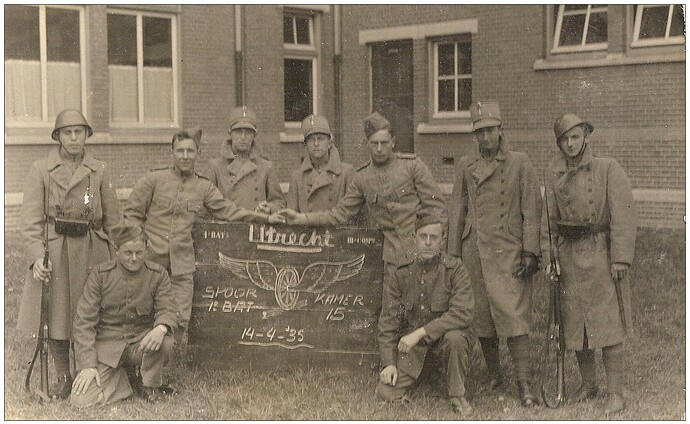I am interested in any information relating to this photo.
You mean aside from the obvious?
Any information would be useful, my deceased father is in the picture (which I found only recently along with a number of other similar photos).
Well, apart from the fact that the photo was obviously taken on April 14, 1935 at Utrecht/Netherlands it offers the following info to me:
these soldiers probably belong to a railway artillery unit, the sign says first battery (the artillery counterpart of a company) and “Spoor” which is the Dutch word for railway. Furthermore these guys were quartered in the barrack’s room 15 (Kamer 15).
Not much really…
Thanks, any information appreciated.
Don’t see many pictures (me at least) of Dutch uniforms from that era. Thanks for posting. Sorry I couldn’t help out with information.
User BG83 asked me to post this information concerning this photo, for some reason he’s not able to place posts himself. Thanks anyway, BG83!
Hey rgg817,
I did some web-based research, it appears that there was a Royal Dutch Constabulary ( sort of Military Police ) training in the ‘Kromhout Kazerne’ ( Kazerne = Barracks ). I found a photo from another training barrack somewhere in Holland. The photo is also dated 1935. Look at the hats they are wearing, it’s almost similar to the ones in your picture. Altough i think the people on the picture i found are nco’s or enlisted at least. Hope you can do something with this info. Note that i’m not sure of this, only did web-based research and using some logic And the ‘spoor’ you see on the sign in you picture does not mean ‘rail’ as someone said in your thread. What i think it means is ‘insignia’ or ‘badge’ ( it’s like a dutch saying: ‘Hij heeft zijn sporen wel verdiend’ or ‘He earned his badge’
p.s. the dutch word for constabulary is ‘marechaussee’ if you hit that on google maybe you find some interesting stuff.
Greetings from Holland
“Military Police” is, perhaps, a slight linguistic slip. We are, I think, looking at the Netherlands Royal Marechaussee - a force very much still in existence. These are best seen, in terms recognised by English speakers as “gendarmerie” (yes, I know, French …) that is to say, a division of the Army that is, in peacetime at least, employed in specific policing functions, or in general support of the civil power. Other examples are the Italian Carabinieri, the Spanish Guardia Civil, and the French Gendarmerie Nationale. In my own country, the pre-Independence Royal Irish Constabulary would have been an exampe of this sort of force - explaining the slightly curious tendency in Hiberno-English to describe a police station as a “barracks”. Technically, in rural areas at least, pre-Independence centres of policing were, technically, military barracks. Best regards, JR.
hi rgg817,
Just ask http://www.collectie.legermuseum.nl/strategion/strategion/i000000.html, they migth know, or know who to contact.
The Dutch army signs are not well known to me, but I noticed that they are not wearing any insigna’s.
I’m pretty sure flamethrowerguy is right on target. Whoever they are, they were attached to the railroad and were part of some sort of railroad artillery. “Spoor” means railroad in Dutch.



